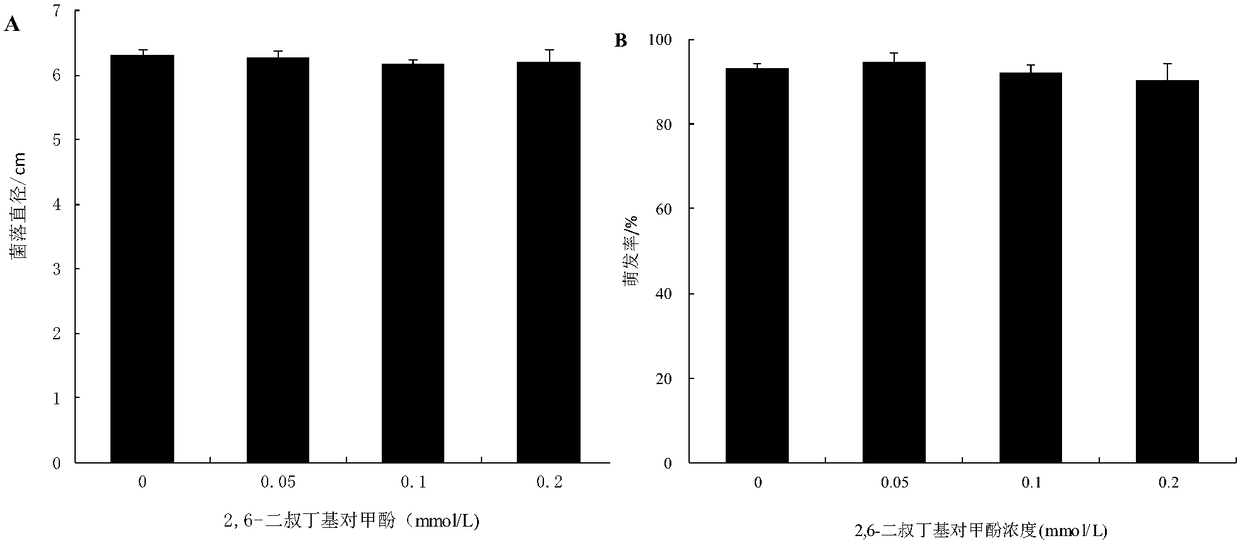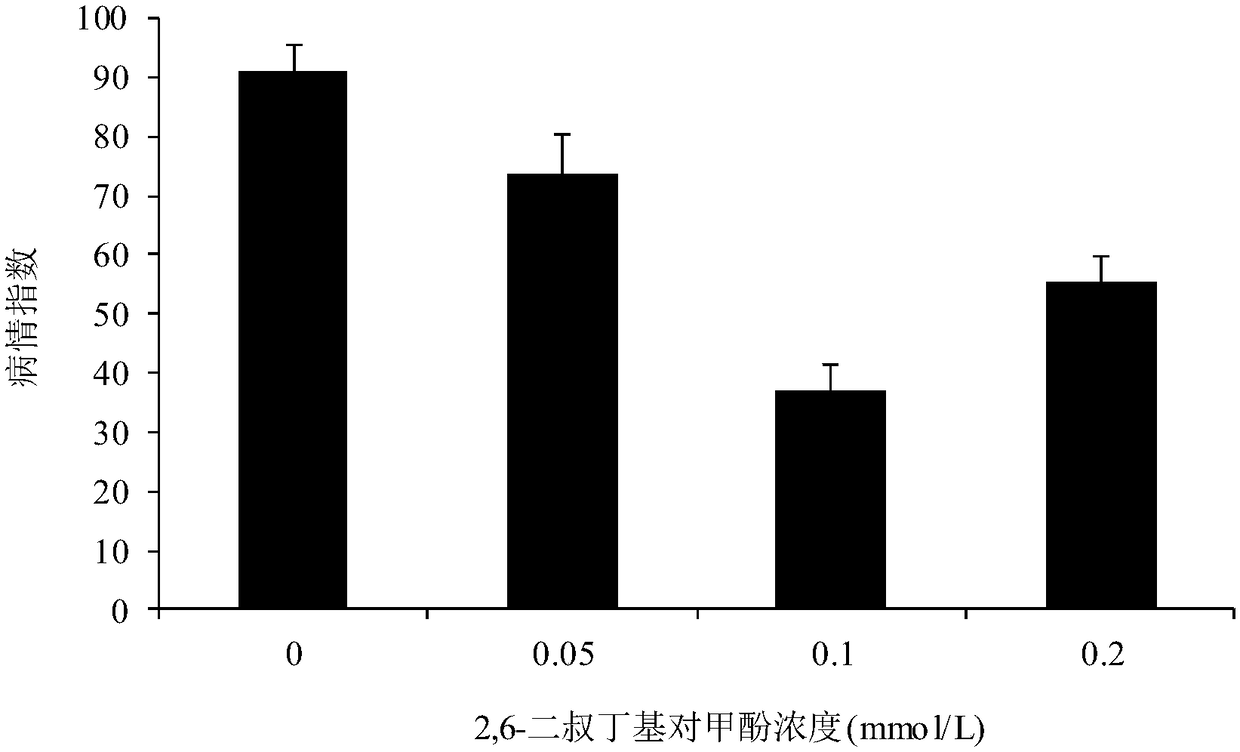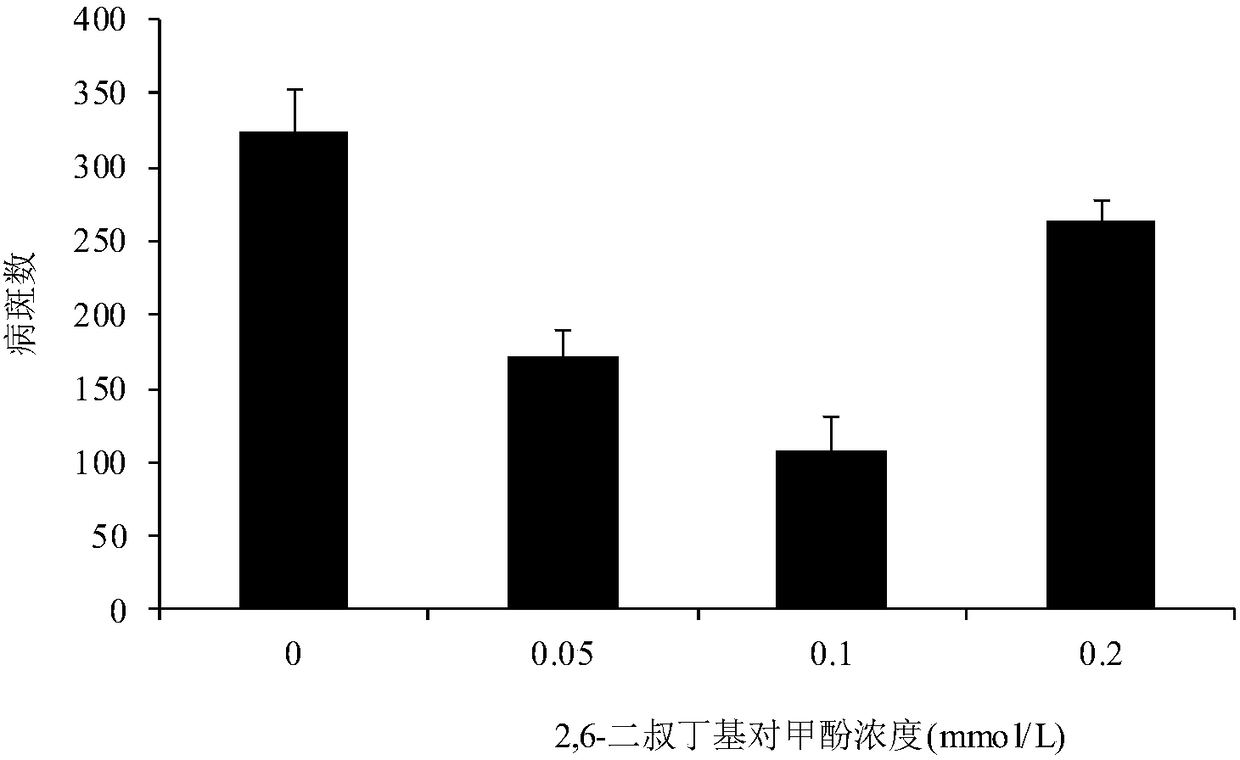Application of 2,6-di-tert-butyl-p-cresol as plant disease-resistant activator in apple leaf part
A technology based on di-tert-butyl and p-cresol, applied in plant growth regulators, applications, biocides, etc., can solve the problems of difficulty in the control of apple leaf diseases, resistance to chemical pesticide residues, and high cost, and achieve elimination The destruction of the weak environment and the impact on human health, the effect of less resistance to drugs and low cost
- Summary
- Abstract
- Description
- Claims
- Application Information
AI Technical Summary
Problems solved by technology
Method used
Image
Examples
Embodiment 1
[0026] 1.1 Effect of 2,6-di-tert-butyl-p-cresol on mycelial growth of apple anthracnose leaf blight
[0027] Prepare PDA medium, add 2,6-di-tert-butyl-p-cresol aqueous solution to it, so that the final concentration is 0.05mmol L -1 , 0.1mmol·L -1 and 0.2mmol·L -1 , Inoculate the activated apple anthracnose leaf blight pathogen Glomerella cingulata into the above PDA medium. The bacterium is a conventional pathogenic bacterium in this field, and it was cultured at 25° C. in constant temperature and dark for 5 days, and the diameter of the colony was measured.
[0028] The above-mentioned PDA medium used has the following components and formula: weigh 200g after peeling the potatoes, cut into small pieces and boil in water for 15-20min, add 20g of glucose and 15g of agar powder after filtering through four layers of gauze, and dilute to 1000mL. The pH value is natural, and it is sterilized by high-pressure steam at 121°C for 20 minutes.
[0029] The results showed that 0.05...
Embodiment 2
[0035] Control effects of different concentrations of 2,6-di-tert-butyl-p-cresol on apple anthracnose leaf blight and brown spot:
[0036] Prepare the spore suspension of Glomerella cingulata, the pathogenic fungus of apple anthracnose leaf blight, and culture the pathogen on PDA at constant temperature and dark. , orange-yellow conidia horns can be seen after 2 to 3 days, prepare conidia suspension and adjust the concentration to 5×10 4 pcs mL -1 .
[0037] The spore suspension of Diplocarpon mali, the pathogen of apple brown spot disease, was prepared. The diseased leaves of brown spot disease were collected from the Jiaozhou Experimental Station of Qingdao Agricultural University. They were incubated at 20°C for 72 hours, and a large number of fresh conidia were produced on the diseased leaves. After that, make it into spore suspension 2~3×10 4 pcs mL -1 .
[0038] Configure 0.05mmol·L -1 , 0.1mmol·L -1 and 0.2mmol·L -1 The 2,6-di-tert-butyl-p-cresol solution, select ...
Embodiment 3
[0045] Control effect of 2,6-di-tert-butyl-p-cresol on apple brown spot and spotted leaf spot:
[0046] Prepare the spore suspension of Alternaria alternate f.sp.mali, the pathogenic fungus of spotted leaf defoliation, and inoculate it on the PDA medium, and cultivate it in a constant temperature incubator at 25°C. When the colonies turn black, Scrape off the hyphae and conidia, rinse with sterile water, filter the mixture through 3 layers of lens-cleaning paper to obtain a spore suspension and adjust the concentration to 2-3×10 5 pcs mL -1 .
[0047] Configure 0.1mmol·L -1 2,6-di-tert-butyl-p-cresol solution, select Fuji apple branches with consistent growth from one to two years with fully expanded leaves, and spray the above-mentioned concentration of 2,6-di-tert-butyl-p-cresol solution evenly until the leaves drip. , with sterile water as a control. After 3 days of treatment with the above-mentioned concentration of 2,6-di-tert-butyl-p-cresol solution, cut the treated ...
PUM
 Login to View More
Login to View More Abstract
Description
Claims
Application Information
 Login to View More
Login to View More - R&D
- Intellectual Property
- Life Sciences
- Materials
- Tech Scout
- Unparalleled Data Quality
- Higher Quality Content
- 60% Fewer Hallucinations
Browse by: Latest US Patents, China's latest patents, Technical Efficacy Thesaurus, Application Domain, Technology Topic, Popular Technical Reports.
© 2025 PatSnap. All rights reserved.Legal|Privacy policy|Modern Slavery Act Transparency Statement|Sitemap|About US| Contact US: help@patsnap.com



